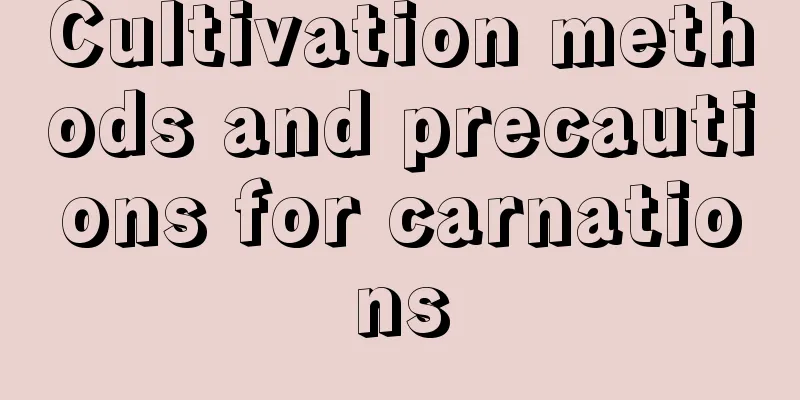Cultivation methods and precautions for carnations

1. SoilSoil is the activity place of plant roots. Creating a loose and breathable environment while having a certain water retention capacity is crucial for the cultivation of carnations. Carnations are flowers with fibrous roots, and their roots grow well in loose, fertile and well-ventilated soil. It is best to choose sandy soil for planting carnations. Heavy and silted soil is not conducive to the growth of carnations and needs to be improved. 2. TemperatureCarnation is a cool-loving plant. The optimum temperature for its growth and development is 19-21℃, and the temperature difference between day and night should be kept within 10℃. If the temperature is too high during the day, carnations will have undesirable phenomena such as small flowers, narrow leaves, and few branches. The temperature between the leaves cannot be too high, otherwise there will be abnormal reactions such as weak stems, small flowers but good color. If the summer temperature is higher than 35℃ and the winter temperature is lower than 9℃, the growth will be slow or the plants will grow poorly or even stop growing. 3. LightingCarnations have very high requirements for light. Except during the seedling or flowering period, there is no need to worry about any adverse effects of strong light on carnations. As a long-day plant, the longer the sunshine time, the more it can promote the differentiation of flower buds and can also bloom earlier. With the help of auxiliary light, not only can the growth of internodes of plants be promoted and the growth of lateral branches be inhibited, but also the diameter of the corolla and the brightness of flower colors can be increased. 4. WateringCarnations are shallow-rooted flowers and the planting depth should not exceed 2 cm. Water once after planting, and then water again when the soil in the pot is dry. Carnations are very intolerant of moisture. Except for the peak growth period, flowering period and midsummer when increased watering is needed, under normal circumstances, do not water too much, just maintain a certain level of soil humidity. Be careful not to let the soil be too dry or too wet during flowering. 5. FertilizationCarnations are shallow-rooted plants, and their roots are generally distributed in a soil layer of about 20 cm, so when planting, sufficient base fertilizer should be applied to the soil. Base fertilizers such as manure, compost, bone meal and other organic fertilizers can improve the physical properties of the cultivated soil and enhance its fertility, making it a humus-rich, light and fertile loam. Carnations need constant fertilizer supplementation during their growth period. The principle of topdressing is to apply thin fertilizers frequently, once every 25 to 30 days. For smaller potted plants, apply fertilizer about once every 10 days. During the peak growth period of the plant, the frequency of top dressing can be increased. Fertilizers can be cake fertilizer water, chicken manure water, or compound fertilizers. 6. NotesDuring the vigorous growing season in spring and autumn, the soil should be kept moist to meet the needs of growth and development. Growth is inhibited during the high temperature period in summer. At this time, watering should be controlled and ventilation should be increased to keep the soil in the pot slightly dry. Generally, the greenhouse is entered before and after the "Frost Descent", and the temperature should be controlled at 10-20℃. In order to delay the flowering period, the temperature can be adjusted up or down appropriately. Efforts should be made to lower the humidity in the greenhouse to reduce the occurrence of diseases. Bring it indoors in winter and cultivate it in a sunny and well-ventilated place. If the temperature is suitable, the flowering period can be extended to March of the following year. |
<<: Carnation variety classification
>>: Cultivation methods and precautions of coleus
Recommend
How to fertilize spring fern
Fertilization methods are different in different ...
How to prune rose begonias and when to prune them
1. Pruning time You can prune rose begonias at an...
Time and method of corn planting in the north
Corn planting time in the north The climate in th...
Oil bean planting time and method
Oil bean planting time Oil beans are generally pl...
How to plant tiger skin orchid
1. Choose the soil Choose sandy soil with suffici...
Can you grow succulents in ordinary soil?
Can ordinary soil grow succulents? Succulents can...
How to change the pot of hibiscus chandelier
The season for repotting hibiscus The chandelier ...
The benefits of placing bamboo cypress indoors (Is it good for human health to keep bamboo cypress at home)
What are the benefits of growing bamboo cypress p...
Where is the best place to plant avocado trees? What are the planting conditions?
Where to plant avocado trees Avocado is native to...
How to grow rainbow arrowroot
1. Soil It prefers well-drained, fertile, loose, ...
How to save seeds of Wutacai
Method of preserving seeds of wutacai Wutacai is ...
How can I make the water-cultured green radish take root quickly? What should I do if it doesn’t take root?
1. Fast rooting method 1. Choose strong branches:...
How to water Tiger Pilan
1. How to water When watering Sansevieria, you ca...
How to make Oxalis germinate and how to plant bulbs
1. How to make Oxalis germinate If you want to ma...
How to grow Clerodendrum thomsoniae in winter? This way is labor-saving and scientific!
Growth habit To understand the winter care of Cle...









